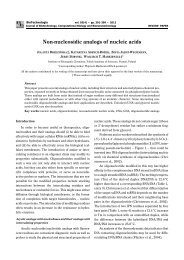Structure and functions of lampbrush chromosomes - BioTechnologia
Structure and functions of lampbrush chromosomes - BioTechnologia
Structure and functions of lampbrush chromosomes - BioTechnologia
Create successful ePaper yourself
Turn your PDF publications into a flip-book with our unique Google optimized e-Paper software.
340K. Andraszek, E. SmalecAvian <strong>lampbrush</strong> <strong>chromosomes</strong> are associated withprotein bodies/structures (PBs). These non-typical structuresare present in cells only in association with LBCs.They have a regular connection with the chromosomeaxis <strong>of</strong> each LBC in the heterochromatin region (Soloveiet al., 1996, Krasikova et al., 2004). In terms <strong>of</strong> morphology,PBs resemble Cajal bodies (CBs) present in amphibiansin association with LBCs. However, immunocytochemicalresearch has shown that PBs neither containp80 coilin, nor any other CB matrix indices, such asfibrillarin or splicing- <strong>and</strong> U7snRNPs-specific trimethyloguanosineepitopes. The distinctive composition <strong>of</strong> PBssuggests a completely different function from that <strong>of</strong>CBs. PBs may be involved in the coordination <strong>of</strong> spatiallayout <strong>of</strong> <strong>chromosomes</strong>. The location <strong>of</strong> PBs is frequentlyassociated with repetitive sequences surroundingthe centromere. Exploration <strong>of</strong> the potential role <strong>of</strong> centromere-related<strong>and</strong> centromeric heterochromatin-relatedproteins in the biogenesis <strong>and</strong> location <strong>of</strong> PBs <strong>and</strong>CBs constitutes a new trend in the research on <strong>lampbrush</strong>chromosome structure (Gall, 2000; Morgan et al.,2000; Morgan, 2002, 2005; Muphy et al., 2002).Lampbrush chromosome transcriptionA routine mitotic chromosome analysis can only providethe description <strong>of</strong> their morphology. Transcriptionalactivity <strong>of</strong> genes can only be assessed using molecularmethods that consist detecting the amount <strong>of</strong> the transcriptionproduct. Transcriptional activity <strong>of</strong> LBCs may beobserved even under a light microscope <strong>and</strong> can bedetermined for morphological changes.Therefore, LBCs are used as a model in studies <strong>of</strong>transcriptional regulation. Changes in transcriptional activityresult in a different morphological structure <strong>of</strong><strong>lampbrush</strong> chromosome loops (Gall, 1983; Morgan,2002). Moreover, a higher transcriptional activity <strong>of</strong>micro<strong>chromosomes</strong> is observed due to a greater density<strong>of</strong> genes (Rodionov, 1996; Angelier et al., 1984; Morgan,2002). Transcriptional activity analyses are performedon the basis <strong>of</strong> assumption that the side loops <strong>of</strong> LBCsare the transcriptionally active sites. A decrease intranscriptional activity is observed as a shrinking <strong>of</strong> theside loops (Varley et al., 1980; Gall, 1983; Callan et al.,1987; Gaginskaya <strong>and</strong> Tsvetkov, 1988; Morgan, 2002,2007; Galkina et al., 2006; Gaginskaya et al., 2009).The morphology <strong>and</strong> transcriptional activity <strong>of</strong> LBCsvary depending on the reproductive cycle (Andraszeket al., 2009). They can also undergo seasonal changes(Tsvetkov <strong>and</strong> Parfenov, 1994). This is particularly evidentin hibernating amphibians. During the summer,when the animals are the most active, the transcriptionalactivity <strong>of</strong> LBCs is the highest, as well. In the autumn,LBCs’ activity abates. Nevertheless, this is not associatedwith morphological changes. At that time <strong>of</strong> the year,each transcription unit contains approximately 10 RNP(ribonucleoproteinic) filaments, while in the summer,this number is twice as high, the change correspondingwith morphological transformation. During the winter,transcription substantially declines. Both in <strong>chromosomes</strong><strong>and</strong> in nucleoli, numerous <strong>and</strong> very characteristicmorphological changes take place (Tsvetkov <strong>and</strong> Parfenov,1994). Not more than 70% <strong>of</strong> the nuclear DNA issubject to transcription at the time. Although in the case<strong>of</strong> physical factors, such as radiation or numerous chemicalfactors, a similar effect on the structure <strong>and</strong> activity<strong>of</strong> LBCs in various groups <strong>of</strong> animals can be expected,seasonal changes predominantly affect polikilotherms(Morgan, 2002, 2007).The degree <strong>of</strong> DNA compaction in LBCs is regulatedby changes in the distance between nucleosomes, especiallythe non-adjacent ones. The compaction ratio <strong>of</strong>DNA (number <strong>of</strong> DNA μm in a 1 μm chromatin fiber)in non-transcribed fibrils is equal to 2.1, in transcriptionalunits with moderate <strong>and</strong> weak activity it is 1.7, <strong>and</strong>in transcriptional units with intensive transcription it isclose to 1. (Franke <strong>and</strong> Scheer, 1978; Gaginskaya <strong>and</strong>Tsvetkov, 1988; Morgan, 2002, 2007). The nucleosomes<strong>of</strong> transcriptionally inactive chromatin are evenly spaced,the gaps between the nucleosomes corresponding withlinker DNA length. In transcription units with insignificantor declining transcription, nucleosomes are identifiedin the axial part <strong>of</strong> the chromosome, between sets<strong>of</strong> polymerase units. The gaps between the polymeraseblocks are not even. After polymerase has passed alongthe DNA matrix <strong>and</strong> the regulatory proteins have becomedissociated, nucleosome reconstruction follows(Spring <strong>and</strong> Franke, 1981; Gaginskaya <strong>and</strong> Tsvetkov,1988; Solovei et al., 1992).In transcriptionally active regions <strong>of</strong> <strong>chromosomes</strong>,histone proteins give way to non-histone proteins, inducingthe loss <strong>of</strong> the nucleosomal structure <strong>of</strong> the codingchromosome segments that assume the shape <strong>of</strong> a loop.However, the exposure <strong>of</strong> nucleosomes, which enablesDNA transcription, does not entail histone dissociation




